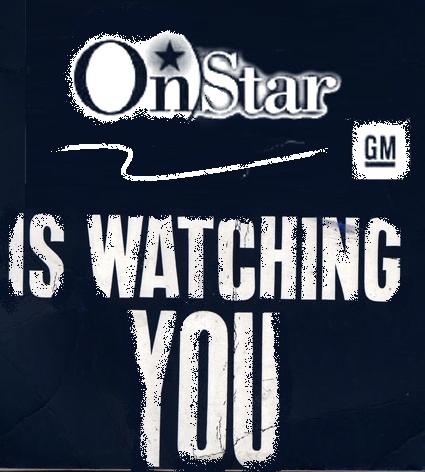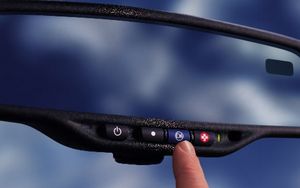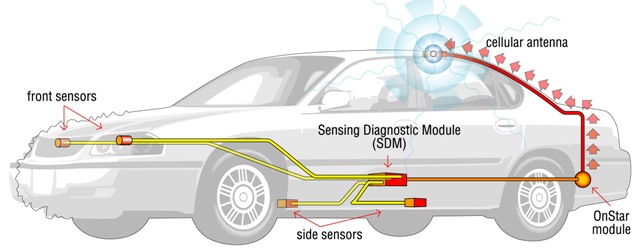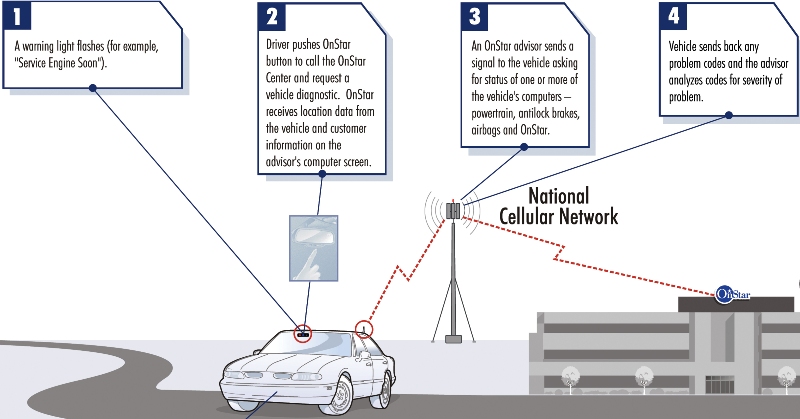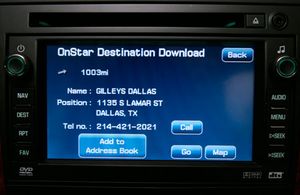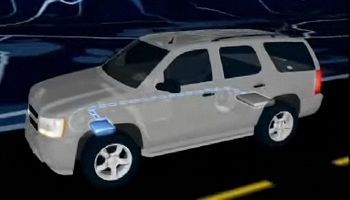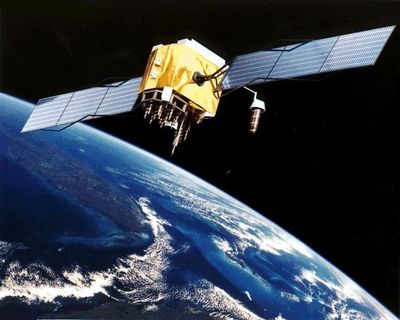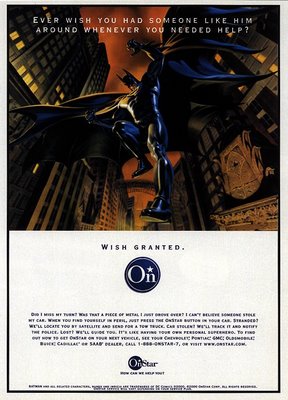Welcome to OnStar- How may we invade you?
Contents
Team Information
Nisha Suri
Mackenzie Campbell
Davana Etwaroo
Michael Ng
Paul Kissinger
Technology and Issue
Technology: OnStar
Issue: The use and obtaining of personal information without customer's permission or knowledge.
Initial Project Statement
We have chosen to look at OnStar technology that is installed in all GM vehicles. We will discuss what OnStar is, its purposes, pros and cons, clauses found in sharing your personal information with OnStar and as well as OnStar sharing your personal information with affiliations. Furthermore, we will look at what customers think about OnStar and argue whether or not the positives outweigh the negatives.
Introduction
OnStar is a unique piece of technology that assists, tracks, and responds to the customer and/or the automobile. It was created in 1995 by three companies and uses GPS (global positioning system) and CDMA (code division multiple access) technologies. There are wide arrays of features that OnStar can be proud of for making its customer’s feel more comfortable and protected. OnStar is installed in all GM vehicles, however even if service is not activated, OnStar can tune in for legal reasons. In order to receive its services, the customer has to give personal information. OnStar has strict policy of safeguarding customer’s personal information, “At OnStar Canada Corporation ("OnStar") we respect your privacy. You don't want your personal information to fall into the wrong hands. Neither does OnStar." However, there are certain clauses that are found in the privacy statement that may leave customers questioning their service.
Argument
While OnStar offers a variety of features with the intention of solving a drivers general problems, what, if anything, must the customer give up in order to take advantage of these features? While examining the pros and cons of the company, do we find that the bad outweighs the good? OnStar's features may be an invasion of privacy that its customers have no control over! The company insists that it only uses its GPS technology against the will of the driver when ordered by authorities (government, police, etc.). Unfortunately, the public could possibly be misguided when it comes to OnStar's involvement with government authorities. Some who purchase a GM vehicle may have the GPS technology implanted into their vehicle even if they do not wish to have it activated. But the hardware could potentially be activated at any time at the OnStar Headquarters. Is it possible that OnStar really is a diversion for the government to place tracking devices in vehicles? Diversion or not, there is proof that the system has been a convenient service to clients and has also saved lives with its Automatic Crash Response feature.
OnStar
What is OnStar?
OnStar services take advantage of GPS (global positioning system) and CDMA (code division multiple access) based mobile phone voice and data communication technologies. The GPS receivers use satellites and precise continual frequency signals that enable them to calculate locations as well as moving speed and direction based on changes in movement. These calculations are typically viewed via an LCD screen in the automobile. The use of CDMA is basically just a way of creating coded channels while using mobile phone services (Verizon in US, Bell in Canada) in order to communicate efficiently with all OnStar's clients. These technologies are used by OnStar by implementing them into vehicles, specifically GM models, in order to offer a variety of features.
History
OnStar was created in 1995 by three companies: GM (general motors), EDS (electronic data systems) and Hughes Electronics. Each contributed with their own areas of expertise. In particular, GM with vehicle design and supply, EDS with system development, information management and customer relation support, and lastly Hughes with electronics specifically designed for implementation into cars as well as satellite or communication technology that it incorporated. In 1996, then GM North America Operations President Rick Wagoner officially launched OnStar at the Chicago Auto Show. OnStar delivered its first product and service to the market in 11 months - in the fall of 1996 for model year 1997 Cadillac DeVille, Seville and Eldorado models. Analog service for cell phone usage became out dated and so, for those with OnStar, only those with a one year (non refundable) subscription would be given a free equipment upgrade. For others, if the vehicle was older than a 2003 model, their OnStar service would no longer be usable. If the vehicle was a 2003-2005 model, it would cost $200 for an adapter as well as a one year subscription, at the customers’ expense. By the new millenium, OnStar celebrated its service to over 500 000 subsribers and was named (by "BusinessWeek") among the “Web Smart 50” as one of the world’s leading companies that harness the power of the Web to create innovative products and services that take new approaches to changing the way global businesses operate. By 2005, it was apparent that the service was highly recognized due to it's 500 millionth purchased "Hands Free Calling" minute. It currently services over 4 million subscribers, but due to it's recent switch from analog to digital signals, OnStar has been forced to drop 500 000 of its subscribers with older modeled GM vehicles.
Features
Automatic Crash Response to EMS
This original feature consists of multiple censors all around the vehicle that send a signal to the OnStar centre in the event of a crash. Even if the airbags do not deploy, an OnStar Emergency Advisor is immediately connected to the vehicle and automatically recieves the vehicle's exact location. The advisor is then able to find out more about the situation by contacting the driver, and if the driver is unable to respond, the advisor sends Emergency services to the exact location of the crash. The emergency advisor relays critical crash information, such as severity, type of crash, velocity of impact, direction of impact, multiple or single impacts, and rollover status; to emergency responders so they are better prepared to treat the accident at the scene. This is beneficial because police, fire department, and EMS are able to know what equipment to send. To give a vehicle the ability to call when it is in an accident, OnStar uses an event data recorder (also known as the Advanced Automatic Crash Notification System (AACN). It's the car's equivalent of an airplane's black box, except that the AACN only starts recording in the event of a crash and only records data. The AACN system consists of four components: sensors, the Sensing Diagnostic Module (which includes the event data recorder), the VCIM and the cellular antenna. The number and location of sensors vary depending on the specific car, but they all work the same way. When the car is in a crash, sensors transmit information to the Sensing Diagnostic Module (SDM). The SDM also includes an accelerometer, which measures the severity of the crash based on gravitational force.
OnStar has recently reported that it has responded to more than 100 000 crash response calls. That is proof that this feature is reducing injuries and saving lives. Although accidents are often reported by witnesses and by telephone, this feature exceeds a simple report of a car accident. By also reporting critical crash information (such as severity of the crash), it allows EMS to do their job more efficiently. More importantly, these reports may increase the odds of a saved life.
Vehicle Diagnostics
OnStar runs a monthly diagnostics test on its five key operating systems and notifies when the owner should contact their GM dealer. The OnStar centre notifies clients about their vehicles through their account. Email notifications may contain any urgent issues, oil and tire status, vehicle and account information, or helpful hints. Through their account, the user may also access maintanence information that highlights the vehicle's systems that require attention on a more regular basis like oil, tire pressure and mileage. The information also tells them when they need maintenance based on personal driving patterns. The online account is also useful for managing features that the user has subscribed, such as the amount of minutes that have been bought for "Hands-Free Calling". OnStar is able to interrogate more than 400 system codes that cover the vehicle's engine and powertrain systems, the antilock brake system and the air bag system. These codes, ranging from transmission fluid temperature to engine misfire, fuel injector malfunction to engine over-temperature protection, represent more than half of all service and repair incidents that a customer may encounter.
Hands-Free Voice-Activated Calling
This feature was introduced in 2002, where the user is able to communicate on the phone while leaving his or her hands on the steering wheel at all times. All the user has to do is push the "call" button, and is able to dial all through voice commands with the sound coming out of the car speakers. Each car comes with its own phone number, it does not connect to a cell phone. The user must purchase minutes either through their OnStar online account or through an advisor. OnStar's cellular service has a better range than most cell phones, with a full three watts instead of a regular cell phone's 0.6 watts. With some OnStar plans, users may also use the cellular service just as they would a regular cell phone plan. For calls to the advisor, OnStar uses voice recognition software similar to that already used in some hand-held cell phones. However, one of OnStar's unique features is the ability to "surf the Web" using the Virtual Advisor automated system. The company recently announced a partnership with Bell Mobility to simplify their mutual customers' wireless communications. The Bell 'Minute-Sharing with OnStar' service plan allows customers who subscribe to both OnStar's hands-free calling service on their GM vehicles and Bell Mobility cell phone services to integrate the two devices.
Not only is this feature more convenient for the client, it is also much more safe for the driver, its passengers, and other vehicles on the road. Several studies show cell phones are a leading cause of car crashes. It is estimated that cell phone distracted drivers are four times more likely to be in a car wreck. According to a Harvard University study, cell phones cause over 200 deaths and half a million injuries each year. With this feature, both hands are on the wheel and talking on the phone while driving is less of a distraction. It may be argued that talking on the phone in general is a distraction anyways, but at least this feature allows the driver to be slightly more focused on the road rather than using a cell phone.
Stolen Vehicle Assistance
This new technology was developed to help reduce the risk of fatalities, serious injuries or property damages resulting from high-speed chases involving stolen vehicles. When there is a stolen vehicle the subscriber reports a the vehicle to authorities and authorities request assistance from OnStar. Using GPS satellite and cellular communications, OnStar pinpoint’s the stolen car’s location and provides it to authorities. OnStar works with public safety officials to varify the vehicle is being treated as stolen. Police establish a clear line of sight of the stolen vehicle and request that OnStar decelerate the vehicle. OnStar can remotely send a signal to the subscriber’s stolen vehicle to interact with the Powertrain system, telling it to ignore throttle input, which causes the vehicle to gradually slow to an idle speed. Pressing on the accelerator after the slowdown signal has been received will not increase the vehicle speed, but all other vehicle systems will remain fully operational (i.e., power steering, brakes, etc). Although the time for this complete process will vary, the vehicle will begin to slow within seconds of the OnStar Advisor sending the slowdown signal to the vehicle. This feature is used only for the purpose of stolen vehicle assistance, and is not used in any other situations, but the service is flexible when law enforcement requests assistance. This feature is expected to be in 2009-model-year GM vehicles. The benefits of this system are immense. High-speed stolen-vehicle chases have been the cause of numerous police-officer injuries and fatalities and sometimes innocent bystanders also become victims. For an overview of the stolen vehicle assistance feature, visit this link: http://www.youtube.com/watch?v=ZIIM8rw0au8Remote Vehicle Services
People locking their keys in their car is a very common situation. By calling the OnStar centre, a remote signal can be sent to the driver's vehicle and unlock the doors. In the event that a user has trouble finding their car in a large parking lot or city street, an advisor can send a signal to the user’s vehicle flashing their exterior lights and sounding the horn.
Roadside Assistance
OnStar's Crisis Assist can recommend the best course of action before, during, and after a crisis event such as a flood, a power outage or a severe winter storm. Specially trained advisers can tell the user the best evacuation route, pinpoint their location for emergency responders, help find medical supplies, a hospital, shelter or hotel accommodations, or connect with family or friends. This service is provided before, during, and after a crisis situation, 24 hours a day. OnStar has parted with the "American Red Cross" to help reach people quickly that are affected by a disaster.OnStar also assists users in any situations where there are malfunctions in the vehicle. By contacting OnStar, the advisor can send assistance from a nearby service provider. In a situation where the user cannot or should not drive their vehicle, OnStar can call a taxicab. If no cab is available, OnStar will try to contact a relative or friend. The user can get an advisor to find a specific business and provide you with its address, phone number and/or driving directions. An Advisor will download the business phone number to your vehicle upon request. For example, one can get an advisor to deliver flowers.
A signficant feature about roadside assistance is it's assitance toward the physically disabled. For instance, if the user needs assistance refueling their vehicle, they can call OnStar. An advisor then locates the nearest gas station and calls that station to make sure that an attendant will be available when the user arrives at the station. OnStar can also call ahead to insure that a hotel or restaurant has the appropriate accessibility accomodations.
If a subscriber wants to access personalized Internet based information such as location-based weather and traffic and stock quotes while they are on the road, Virtual Advisor allows the customer to do so on a hands-free, voice-activated manner. The information is delivered through the vehicle sound system speakers the help drivers keep their hands-on the wheel and eyes on the road.
Electronic Stability Control (a future technology)
By the end of 2010, GM plans to plans to have electronic stability control in all GM vehicles. Stability control systems apply brakes to individual wheels if they sense the driver is swerving off course. Twenty-one percent of 2005 vehicles sold in the United States have the systems and an additional 19 percent offer them as an option, according to the Insurance Institute for Highway Safety. Several recent studies have indicated the systems help drivers avoid accidents. IIHS, which is funded by insurers, found stability control could save up to 7,000 lives each year if it were standard equipment on all vehicles. In September, the National Highway Traffic Safety Administration found stability control reduced one-car crashes by 35 percent when compared to the same models sold in prior years without the technology. The rate climbed to 67 percent for SUVs.
Privacy Issues
Questionable Clauses Found Within OnStar's Privacy Statement
OnStar takes customer’s privacy very seriously, however there are certain clauses found on the privacy statement. They will collect information from the use of their services, for example the websites you visit and the calls you make. According to the privacy statement they are required to “comply with legal requirements, including valid court orders of showing probable cause in criminal investigations.” “Imagine the following scenario. The FBI shows up at OnStar master command and tells them your car's been stolen by a terrorist, who may be using it to commit a crime at this very moment. Contacting the owner is out of the question; the owner may also be a terrorist. What does OnStar do? They cooperate with the FBI and give them everything they've got on your car. No warrant needed and no notification to you. You may not even have the service enabled" (2). OnStar is permitted to share contact and current service information with your maker, car dealer, satellite radio providers, and wireless service provider. Service is provided through wireless networks and it is illegal for “unauthorized people to intercept you calls” but it could occur.
OnStar can use customer’s information for independent use to gain personal information to make the technology better or for other uses that users are unaware of. Although OnStar has ensured that within their privacy statement that all the information collected is fairly constricted, there is the concern of some aspects that seem to legally permit OnStar to distribute some of your information. The ability to share such information is credited towards the “purpose of offering you their products and services” (1). It is possible that someone subscribing to the service will unknowingly provide personal information to OnStar with the assumption that it will remain private, when in reality this information is available to certain companies in affiliation with OnStar. Once this information is gathered it belongs to them. This information includes contact information (for example name, mailing address, email address, and phone number), credit card and billing information (1).
It is mentioned on the privacy statement that “OnStar reserves the right to alter its privacy principles as business needs require" (1), which states that it accepts no responsibility for "accidental or involuntary disclosure" of customer information and it reserves the right to change its policies.
Legal Issues
OnStar has come into some legal problems recently. On January 1, 2008, OnStar made the switch from digital to analog (2). By doing this they made a number of current GM car systems useless. In order to be able to use OnStar again, users will have to upgrade their systems to Digital. This can be done, however the costs will not be covered by OnStar but by the individual. This of course leaves a lot of customers angry as OnStar has made no attempt to reimburse the consumers that lose (3). However the blame cannot fall on OnStar alone. They had to make the switch from analog to digital because the telephone companies that provide their service made the switch (4). This service is one of the key aspects of OnStar, so in order for them to continue providing the convenient services to customers, the switch had to be made. OnStar has offered to provide a full year’s service to those upgrading their system’s to digital. OnStar hopes that by offering this incentive, users will not give up on their service. The upgrade can be purchased and installed at dealerships (5). Unfortunately not everyone can upgrade to digital, all cars produced before 2002 cannot be upgraded because their wiring is far too different. Some cars produced in 2002 and up however can be upgraded (5).Another lawsuit filed against OnStar involves a teenager’s death. The parents of Dustin Bambarger have filed a lawsuit claiming that OnStar refused to locate their car when it and Dustin went missing. A couple days later Dustin was found dead in it. The parents believe that this could have all been prevented if OnStar had activated the GPS system in the car (6). OnStar states that they know the location of your car when the user initiates a request, if the air bags have been deployed, if an automatic crash response occurs, or once again to comply with legal requirements (1). As a result, the Bambarger’s claim that OnStar could have easily located their car. OnStar however claims that they could not have located the car because the Bambarger’s did not have an active subscription. There is no real way to tell who is in the right in this situation. However one would think that in this day and age and considering the major advances in technology, OnStar would have been able to locate the car.
As with any system, OnStar can be hacked. For those with the technological prowess, their OnStar unit can be modified to make it compatible with commercially available software on the market (9). There are many websites and message boards that have been set up to display a step-by-step guide to modifying the units. As a result, OnStar’s GPS system can be tapped into. The regular cost of this service is $400 a year (10). OnStar will stand to lose a lot of their money from these modifications. However a majority of OnStar’s other offered services cannot be utilized. The only thing that these modified units can use is the GPS system.
Slippery Slope
Although OnStar is becoming more widely recognized as a positive addition to cars to ensure safety with its various features, it raises the question of what this addition will bring in the future. Could the seemingly insignificant clauses or legal issues mentioned above become blatant attacks at privacy rights?
The expansion of OnStar's market seems inevitable as their products are met with success, but the corporation being a subsidiary of GM made it unlikely that it would be found in other makes of vehicles. However, competitors are entering the market offering products similar to OnStar in order to maintain interest as GM has increased its edge with this added security feature. Additional features and different models become plausible with these new companies. One example of a competitor is Hughes Telematics (1). The Hughes Telematics system is similar to OnStar in the security features offered, however, there is more of a focus on entertainment within the Hughes system. They claim to provide “infotainment”, music and other entertainment as well as location-relevant information (9). This is a reflection of the new generation of telematics systems as we see new systems operating much like new phones, offering e mail, texting, and entertainment. As well, these services are currently being focused on luxury makes of cars such as the Chrysler LLC and Mercedes-Benz, which is the focus of the Hughes system. The installation of the Hughes Telematics system in these makes is expected to occur in late 2009, with a prediction of "...all major automotive OEMs to have a system no later than 2011" according to Phil Magney, president of Telematics Research Group (1).
Another system coming out is the Microsoft Sync system which is also focused on entertainment. The focus for Sync is "Fully integrated, voice activated in car communication and entertainment system for your mobile phone and digital music player." (7). This system is focusing on Ford, Lincoln, and Mercury products.
So with the emergence of these new systems and seemingly broadened communication and entertainment horizons, the future of vehicles seems bright with new technology. However, these new features hold drawbacks. The rate at which these competing systems are made available in vehicles is slightly alarming. OnStar was established in 1995 and has only recently made the products available and we are quickly seeing the emergence and installation of such systems as the Hughes Telematics System and Sync in 2009. As the services quickly become available in the new cars it becomes increasingly difficult to avoid such a system. Privacy concerns are being quashed by various carefully worded privacy statements, however, the persistance of certain loopholes such as the statement within OnStar's privacy policy: "We may change this statement at any time by posting a notice on the OnStar website." (6) showing OnStar's reservervation of the right to alter its privacy principles as business needs require.
As the volume of services available and companies offering the systems increases, there is rising concern over privacy issues. Eventually, as competitors flood the viable market for telematics systems, they may no longer be optional, they may become deemed critical for safety and reservations concerning privacy will no longer be considered. Of course, this concept remains far fetched in today's market, but the emergence of new features draws us a little closer. As tomorrow's telematics are said to offer: Audio and communication, voice activated commands, emission diagnostics, and he ability to track driver location and behaviour (1), there is more reliance placed on the system for safety and information.
Dealing with the ability to track driver location and behaviour alone raises some privacy concerns. The Hughes system is an example of this concept with a feature known as "teen tracking". This feature can be set up by parents to track location and speed limits to observe the young drivers tendencies. There are concerns that this feature could be used for other members of the household, turning the system into a surveillance set up (1). This progress echoes a "big brother" concern and may lead to even more invasive features.
It is also possible that having all our eggs put in the OnStar basket could affect us negatively. We may become too dependent on the security features of these telematics systems as we rely on features such as the stolen vehicle tracking or remote door unlock (6). Can we remain in control of our cars if they have so much technology behind them allowing us to simply be told everything is ok? The concept of privacy invasion is fairly abstract currently as the positive features of OnStar and other systems are recognized by the majority of the population. The expansion of security and safety technology should be explored. Attention must be paid, however, to the amount of information and faith we put in systems as they begin to hold so much control over our lives.
Customer Reviews
For real stories that support many OnStar features, feel free to view the following links:
http://www.onstar.com/us_english/jsp/popup/explore/basics/real_stories/porter.jsp
http://www.onstar.com/us_english/jsp/popup/explore/basics/real_stories/mallard.jsp
http://www.onstar.com/us_english/jsp/popup/explore/basics/real_stories/garner.jsp
http://www.onstar.com/us_english/jsp/popup/explore/basics/real_stories/macneil.jsp
http://www.onstar.com/us_english/jsp/popup/explore/basics/real_stories/morris.jsp
Conclusion
OnStar is known for its features and distinctive protection programs. The OnStar service has demonstrated that the many security advancements offered to you have the potential to make a significant difference in your life. The success seen in the production of OnStar is serving as a benchmark for the aims of other companies in the same field. Telematic systems seem to be the future of automobiles and although OnStar is faced with privacy issues, the trend seems to be towards the support of these devices. The question still remains whether these telematic devices will prove to be useful safety devices in the future or if they will become an issue of personal privacy as we advance forwards with new technology. At the end of the day, if one has a problem with the service, or if one believes that the service is in fact an invasion of privacy, they have the simple option of purchasing a vehicle that is not produced by GM. In the future, it is possible that this type of service may become mandatory in all vehicles, such as the seatbelt has become. This possibility may raise controversy in society due to it's ability to track virtually anyone who owns a vehicle through the GPS technology. Would the public be offended by this system of tracking? Or would the public just allow it to happen as long as the system is used for the good of humanity. Many questions arise about the future of this service, but for now, OnStar is recognized as a service that has saved numerous lives and injuries. Through our reserach, we have found more success stories rather than complaints about the service. Any product that has the ability to save lives should have the right to continue to.
References
Nisha
1. http://www.onstar.com/us_english/jsp/privacy_policy.jsp
2. http://www.thetruthaboutcars.com/onstar-big-brothers-eye-in-the-sky/
3. http://news.zdnet.com/2100-9584_22-132934.html
4. http://www.signonsandiego.com/uniontrib/20041127/news_lz1d27onstar.html
5. http://www.motherjones.com/commentary/columns/2001/04/newshole6.html
6. http://www.suddenlyeverythingsucks.com/issues/privacy_onstar_gps_tracking.shtml
7. http://www.drivers.com/article/453/
8. http://en.wikipedia.org/wiki/OnStar
9. http://www.associatedcontent.com/article/418218/onstar_violation_of_privacy.html
10. http://en.allexperts.com/e/o/on/onstar.htm
Mackenzie
2. http://news.cnet.com/2100-1029_3-5109435.html
3. http://www.associatedcontent.com/article/418218/onstar_violation_of_privacy.html?cat=4
4. http://www.huffingtonpost.com/steve-parker/gm-and-onstar---pushing-o_b_132487.html
5. http://www.motherjones.com/commentary/columns/2001/04/newshole6.html
6. http://www.onstar.com/us_english/jsp/privacy_policy.jsp
7. http://www.syncmyride.com/#/overlay/overlay_driver_services
9. http://www.hughestelematics.com//products/consumers/infotainment/
10. http://www.the-infoshop.com/press/bc20873_en.shtml
Davana
1. http://www.onstar.com/us_english/jsp/privacy_policy.jsp
2. http://www.instituteforlegalreform.org/media/displayarticle.cfm?artid=ILLI1252899787
3. http://www.autoblog.com/2007/05/11/a-subscriber-scorn-onstar-goes-black-customer-sues/
4. http://www.autoblog.com/2006/11/20/onstar-going-silent-on-millions-of-vehicles/
5. http://www.lawcash.com/attorney/4982/gm-onstar-lawsuit.asp
6. http://www.onlinelawyersource.com/news/onstar-death.html
7. http://www.onstar.com/canada_english/jsp/explore/onstar_basics/real_stories.jsp
8. http://www.schneier.com/blog/archives/2007/10/onstar_to_stop.html
9. http://techdirt.com/blog.php?company=onstar
10. http://www.stormfront.org/forum/showthread.php?t=106978
Michael
1. http://autos.canada.com/news/story.html?id=217af162-76da-4cc6-a078-7106b11583d6
2. http://www.productivitydevelopment.com/38%20OnStar.pdf
3. http://www.autonet.ca/autos/news/2005/01/31/4818211.htm
4. http://www.canadiandriver.com/articles/jk/061122.htm
5. http://www.autoblog.com/2008/04/02/onstar-reveals-trio-of-new-navigation-features/
6. http://www.williamsonuxbridge.com/PDFs/GEN82091%2010.5x20.1825-022.pdf
7. http://inventorspot.com/articles/onstar_adds_more_featuresagain_12904
9. http://trucks.about.com/od/truckaccessory/a/OnStar.htm
11. http://www.car-accidents.com/cell_phone_car_accidents.html
Paul
1. http://www.youtube.com/watch?v=a0Zaz4_9UDw
2. http://www.onstar.com/us_english/jsp/explore/onstar_basics/real_stories.jsp
3. http://en.wikipedia.org/wiki/Onstar
6. http://en.wikipedia.org/wiki/GPS
7. http://en.wikipedia.org/wiki/CDMA
8. http://en.wikipedia.org/wiki/Electronic_Data_Systems
9. http://en.wikipedia.org/wiki/Hughes_Electronics
10. http://www.canadiandriver.com/articles/jk/ten-years-of-onstar.php
